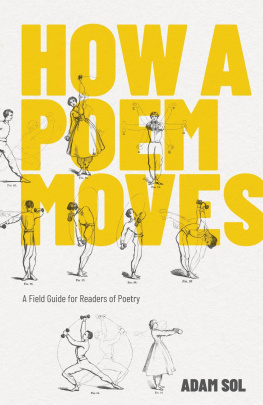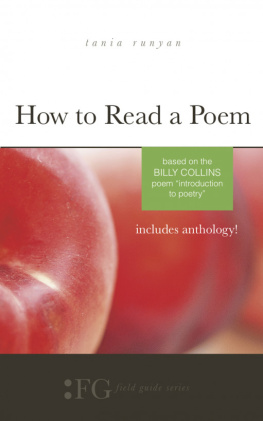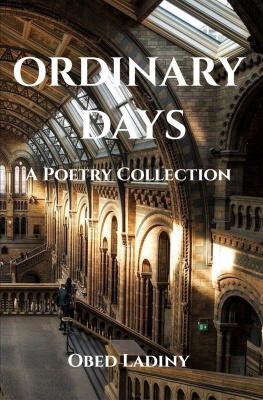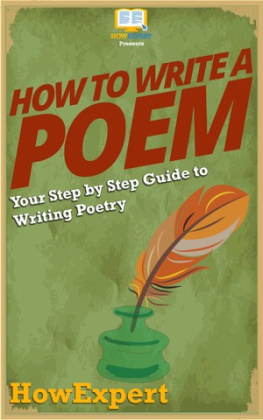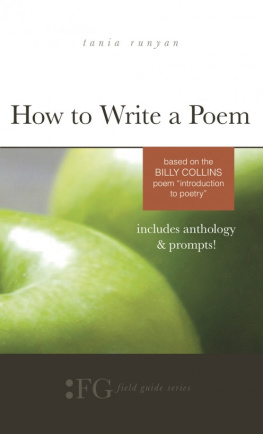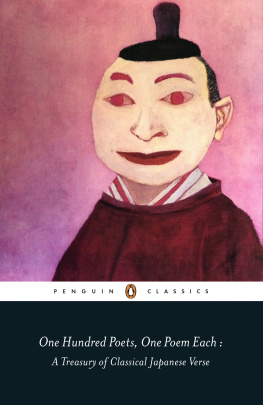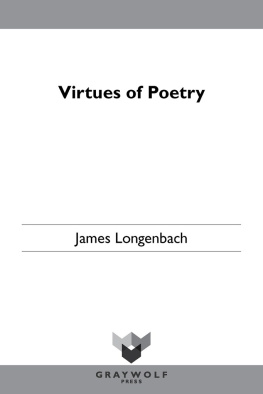Heres something that makes me crazy: I know dozens of readers smart, informed, enthusiastic readers of fiction and non-fiction of all kinds who are afraid of poetry. Who fear they dont get it. If you are one of these people, this book is for you.
Im not going to try to make a case for why poetry matters. Im going to just work from the assumption that poetry matters. It matters to me. It matters to the thirty-six poets included here. And it probably matters to you; if you dont think poetry matters, you wouldnt have bought or borrowed or stolen this book. So well leave the generalizations about poetry to others. Ultimately I cant say I get very excited about trying to define what poetry is. Im more interested in what poetry can do. So while Im not going to be afraid to get a little professorial if a term or technique needs some explanation or context, Im going to do my very best to steer clear of big sweeping generalizations. Were going to dig in and get our hands dirty in the details.
The premise Im working with is that, like a cookbook or a field guide, the best way to learn about a subject is to watch someone do it, so you can see that its not as hard as it may seem, so you can start to do it yourself. The metaphor I like best is the enthusiastic park ranger. I may have a bit more expertise in seeing the flash of bouncing yellow in the distance and knowing its a goldfinch. Im familiar with the landscape and know good places to look for things. But my only job and hope is that I can show it to you so that you say, Hey, I see it! Its even better if, the next time you see that bouncing yellow in the distance, youll be able to say to yourself, without me, Thats a goldfinch.
This project got started when I had the honour to serve as one of three jurors for the Griffin Poetry Prize for 2015. From November until late March 2016 I read over 630 books of poetry from all around the world and then discussed those books with my incredible fellow jurors, Tracy K. Smith and Alice Oswald. Seven of those books made it to the Canadian and International Shortlists. As the process progressed, I kept thinking, How can I make use of all this good reading? How can I shed light on some of these other books that arent making it to the shortlists? There were terrific books that had to be put aside. Even uneven books often had stellar poems inside them. And I wanted to find a way to revisit them once the whirlwind of the jurying process was complete.
The answer I came up with is a blog called How a Poem Moves, which has evolved into the book you now hold in your hands. There used to be a regular column in one of the Toronto newspapers called How a Poem Works, and I always enjoyed the format of short informal essays talking their way through poems, though I never liked the verb they used in the title. I like how art moves more than I like how art works. So for a year I posted an essay every two weeks, creating twenty-five entries. Most of those essays are now here, but Ill eventually get the blog running again, so if you are curious you can find it at https://howapoemmoves.wordpress.com.
The response I got to the blog was very satisfying. Of course the poets themselves were pleased. More than anything, poets want attention paid to their work, and so even if my treatment of their poems was not exactly what they intended when writing them, they appreciated my enthusiasm and care.
But most of my readers were of two types first there were the poetry insiders who appreciated being introduced to a poem or a book that they hadnt encountered, or maybe seeing my reading of a poem they did know. The poets themselves fit into this category. If you are one of these readers, welcome. Many of you could probably write equally interesting essays about other poems, and I hope you will. I dont own a copyright to the format. For you, this book might serve as a sort of travelogue of my jury experience from 2015 a hey, did you see this? My Canadian readers might have missed Diane Seuss or Natalia Toledo. American readers might have missed Jeff Latosik or Rahat Kurd. Ive generally avoided the big names, who get more attention paid to their work elsewhere. And so if you havent heard of many of the poets included here, I hope youll have reason to find out more about them.
The majority of the blogs readers though were not what Id call professionals. They were the moms at my kids school pickup line. They were students. They were colleagues from other disciplines. My mother. These people are serious readers who rarely pick up poetry because they are worried about doing it wrong. If you fit that profile, thanks for joining me. I flatter myself to think that the project might provide a public service not just for readers like you by giving you access to contemporary poems, but also for poetry, by giving it access to more contemporary readers like you. Thats how the blog started transforming itself into a book.
Ive started with four background essays about some of the first poems I fell in love with as I was learning about poetry. These are the oldest poems being examined here, though they only go as far back as the late 1980s. The last seven essays are about the books that were chosen as the finalists for the Griffin Prize in 2016. In between are twenty-four poems that range from the surreal to the heartbreaking, the dense to the breezy, the traditional to the experimental, the formal to the freakish. I did take some care linking essays about poems that have something to do with each other, so there is an arc if you care to find one. But there is not a curriculum you are not required to read this book straight through. Feel free to skip, circle back, scan or skim. If you like a poem, read the essay. If you dont like the poem, read the essay and see if I can change your mind. You are not required to change your mind. You are not being graded.
One thing I tell my students all the time, and maybe its a good place to end this introduction: dont worry at first about what a poem means. Meaning is only one of the things that a poem does while its moving down the page. Instead ask, What does the poem do? This allows us to start off with some simple answers like, It uses regular stanzas, or It describes a scene with birds in it. This question also focuses us right away on the pleasures a poem provides. We dont watch an accomplished dancer and ask ourselves, What does that dance mean? We dont look at a painting and worry at first, What is the meaning of that colour choice? We might do some of that later, but our first response tends to be, Wow. Id like to get you to Wow with each of the thirty-five poems included here.
Okay, enough preamble. Lets get to it!
I was only seventeen when I started as an undergraduate at Tufts University, outside of Boston, but I already knew that I had literary ambitions. Hearing this, an upperclassman said to me, You should take Levines class, The Poem. Its not supposed to be for freshmen, but he doesnt care. Come to a few classes and hell sign you in.
So my friend Risa and I gamely attended while this gruff, brilliant, wiry man with a ferocious moustache brilliantly opened poems to us, interspersed with terrifying workshops and occasional rants about the Tufts administration, American politics, and dogs. Levine was Philip Levine, whose hard-nosed lyric poems earned him an international reputation, a cartload of awards, and a post as the Poet Laureate of the United States.

